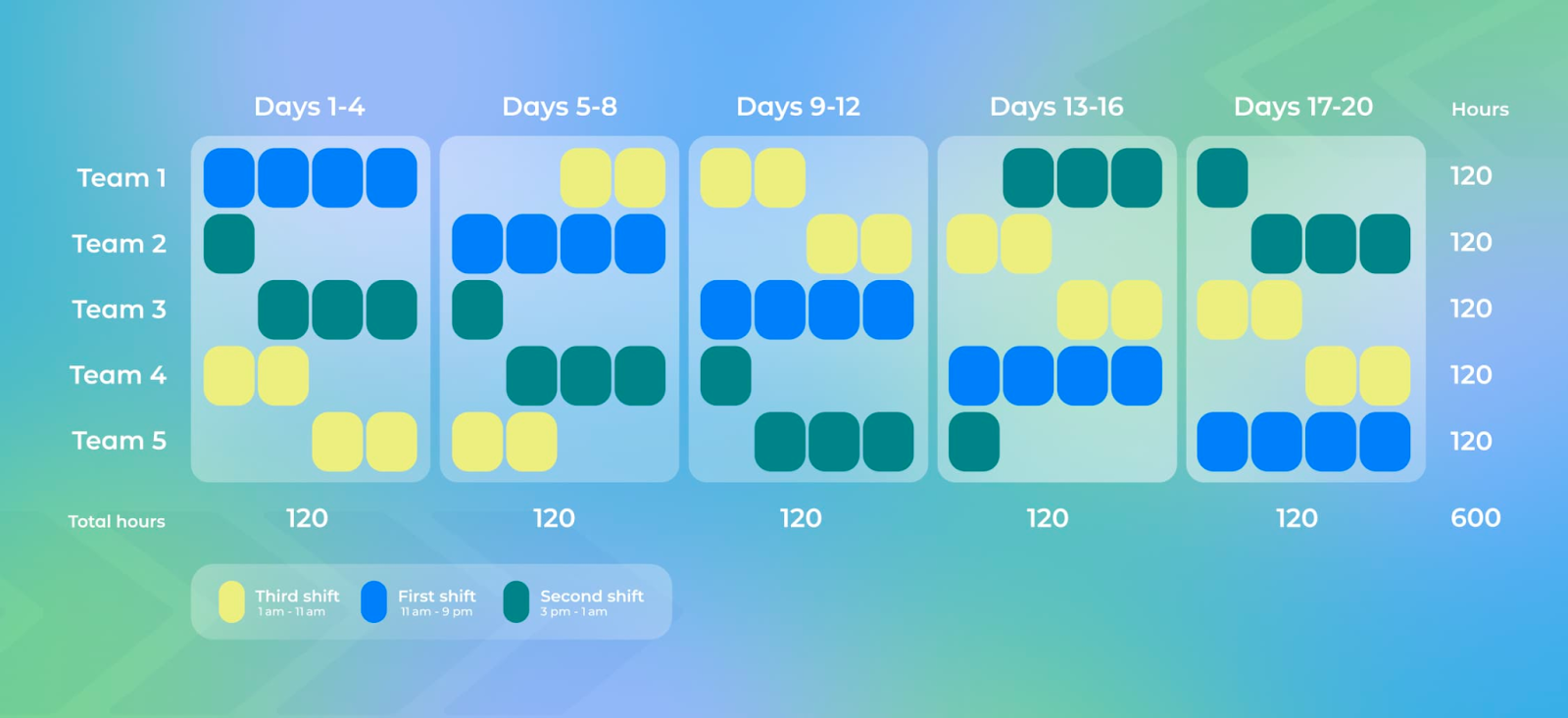
Following the advent of COVID-19, 65% of employees prefer working from home. With the rise of remote and mobile workplace models, finding the ideal balance that’s suitable for firms might be challenging – because there are many factors to take into consideration when creating a scheduling calendar.
In such a scenario, remote woking schedules that are driven by rotating shifts are excellent. The framework enables businesses to maximize their employees’ personal time while maintaining their productivity and providing workers with the support they need.
Changing working hours give workers a chance to gain knowledge about various aspects of the company while assisting employers in achieving organizational targets.
In this article, we’ll cover the advantages of such a scheduling method for both companies and professionals.
The benefits of rotational shifts for both workers and organisations
Let’s start with how rotating shift schedules benefit employers. If you’re a manager leading a team, read on!
Composite training possibilities Each business experiences hectic and slow seasons. These times occasionally change over a few days — particularly when your firm operates in the customer service sector.
Inside a manufacturing plant, the same holds true. In this industry, shipments only can reach between 9 am and 5 pm. Hence, daytime shifts frequently have a higher volume of work than evening hours.
It implies that on some of the quieter and slower nights and weekends, your employees will get superior training. Your instructors will have more time to devote to imparting to workers the fundamental abilities required to carry out jobs properly.
People will be ready to handle the responsibilities when they transition to a fuller schedule. They’ll be prepared to discover more information as well. As a result, your staff will develop into a more versatile workforce.
Enhanced learning with smart Excel schedules
Rotating shifts give your staff more learning possibilities. They’re able to pick up new skills based on the hours they operate. Appropriate educational opportunities arise as a result of the various responsibilities employees handle during various shifts.
A smart way to give a boost to diverse learning opportunities is to initially understand how to make a schedule in Excel. Think of ways to swap tasks during different shifts in your Spreadsheet – so that each employee gets an option to learn something new in every rotation.
For instance, a worker who regularly works in the middle of the day will acquire new compliance or safety operating abilities when working the night shift. It’s advantageous for individuals to continue growing in their industry if they’re given the chance to acquire knowledge and abilities.
More diverse work
With the advent of the Great Resignation, keeping your employees away from monotony is critical. Rotating shifts provide your staff members with more diversity in their employment since they’re continually working on new projects. Usually, the activities employees complete while being on assignments vary – based on the hour of the days they operate.
For example, a civil engineer employed in the daytime may carry out different tasks than one employed during the evening. These variations, which might result from alterations in the surroundings or other circumstances, help give employees diversity to maintain their focus. Intense emphasis on a range of tasks also increases team effectiveness.
Extra perks to employees from your firm
With work that has rotating shifts, individuals end up receiving a few extra benefits based on the timetable they’re contemplating. Some firms arrange their work arrangements such that employees receive a little break each month.
Others might make sure they get a certain number of consecutive days free. For instance, if someone works two consecutive 8-hour shifts, they might get the following three days off. Alternating roles pay more as well.
Numerous employers who offer rotational or night hours pay their staff more hourly wages or compensation rates. Professionals get some excellent vacation time and increase their earnings if the shifts rotate.
Greater engagement at work
Utilising rotational shifts has the benefit of improving workplace engagement since training in new procedures motivates your staff to collaborate more. For instance, if one colleague has experience with shift-specific responsibilities but another doesn’t, the former may try to assist the latter.
As individuals are more proactively collaborating to accomplish goals, there may be a higher level of participation at work. And greater workplace involvement leads to maximizing the potential of your business in terms of performance and growth.
Let’s now explore the top five advantages of rotating shifts for you as a part of the company’s management.
Benefits of implementing a rotating shift schedule for employers
Equal distribution of workload and skills Spreading your top achievers across all schedule variants is an advantage of shift work that’s frequently neglected. Having somebody with specialised talents regularly shift into different schedules helps you avoid recruiting experts in the field you don’t require – as they can be in short supply for numerous tasks.
Additionally, service-based companies have the ability to guarantee a positive client experience at any moment during the day. The increased strain in peak traffic and the stress of lost sleep throughout graveyard hours can be divided by using a rotational shift.
It also permits employees to occasionally take the weekend away. Each person alternates between working their preferred shift and completing the hard hours. It encourages team unity among coworkers. Even senior employees partake in the loop, giving the whole thing an impression of fairness and inclusivity.
It fosters more team camaraderie and a deeper perception of your company when the complete unit is exposed to one another and all workplace circumstances.
More experienced employees
Due to the fact that employees operate at various times throughout the day, they’ll gain greater experience performing a variety of tasks. Rotating shifts makes sure everyone has the chance to attend important conferences and training events because many of them occur during daylight hours.
Shift changes are advantageous to employers since they keep your employees’ work interesting. They won’t be as prone to become complacent as their schedules plus employment experiences will be continuously shifting.
Strengthened morale and cooperation
There are frequently many shifts employed 24 hours a day in many businesses. Construction and engineering firms are typical applications.
The graveyard shifts are obviously the least preferred. One group of workers taking undesirable shifts might lead to division in the workplace. One that might cause shift hostility, poorer attitude, and decreased production.
Each worker takes a turn working a less appealing shift when there’s a rotating shift pattern, resulting in the inverse result. Employee happiness increases productivity. Consequently, it’ll be beneficial in the long term to develop a framework that raises enthusiasm and distributes your workforce’s suffering fairly.
Employees who work different shifts benefit from interacting with a wider variety of people, including clients, contractors, suppliers, coworkers, as well as other partners.
In certain rotational schedules, 8-hour intervals with extra days off are possible. Although they seem more difficult, they actually provide more freedom and extended periods of time off. Here, instances like law enforcement officers and medics are frequent.
Flexible work schedules for your staff
This is essential if your company has to keep changing seasonal and staffing concerns. Additionally, an unusual job gives workers plenty of time to connect with their acquaintances. Many workers like the flexibility of a shift work plan considering they’re informed beforehand.
Eventually, productivity at work increases after your staff manages to adjust to such adjustments. You, as an employer, should consider what kind of rotational timetable will be most effective for the business.
Increased effectiveness
Your workers can manage all the shifts while still obtaining enough rest if they work rotating shifts. Shift-related manufacturing hiccups are also minimized, if not entirely removed. Additionally, if your company’s shifts are separated by 60 minutes, it’ll be easier to transition between them.
Additional advantages in terms of security and risk reduction come from shift work. A well-balanced regimen will result in fewer mistakes and accidents.
Additionally benefited are positions in the culinary and services sectors, since everyone may make more money then. Off-peak times can be used for training, which will help your personnel work more productively and effectively.
In fact, your corporation itself may profit from different shifts the most. Although having people work continuously has several advantages, having them work continuously has the most advantages in terms of satisfaction and keeping things in check — leading to enhanced efficiency as a whole.
With a few crucial factors in mind, move to a rotating shifts schedule successfully
The transition to changing shifts may be challenging for certain workers. Employ scheduling tools, give staff guidance on how they can effectively plan for different schedules, and make it possible for them to switch shifts by following established protocols.
Give workers advance notice of their calendars, and allow them to pick their desired schedule. If possible, try to accommodate these requests.
As a manager, you should create schedules that work for your business and its employees. Everyone will be capable of working on the weeks and at the hours they find most suitable for them in this way. Using rotating schedules serves as the finest approach for accomplishing this.




























